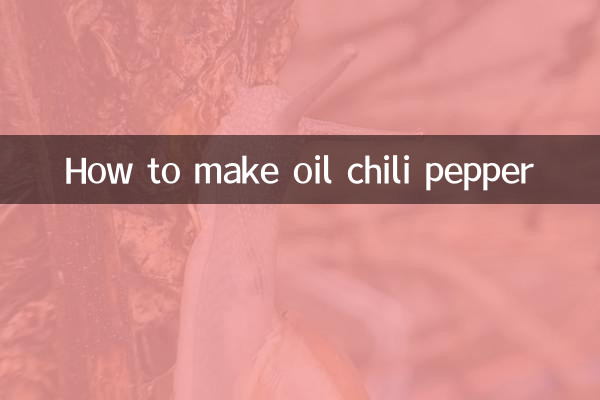How to make oil chili pepper
In the past 10 days, the popularity of food preparation has continued to rise across the Internet, especially the preparation methods of home-made condiments. As a versatile condiment, oil chili pepper can not only enhance the flavor of dishes, but also meet the taste needs of different people, and has become one of the hot topics. This article will introduce the preparation method of oil chili in detail, and attach structured data to help you easily master this delicious secret.
1. Ingredients for making oil chili peppers

To make oil chili, you need to prepare the following materials. The specific dosage can be adjusted according to personal taste:
| Material name | Dosage | Remarks |
|---|---|---|
| dried chili pepper | 100g | Different varieties can be chosen according to spiciness |
| edible oil | 200ml | It is recommended to use rapeseed oil or peanut oil |
| minced garlic | 20 grams | Optional, add flavor |
| minced ginger | 10 grams | Optional, add flavor |
| Sesame | 10 grams | Optional, adds taste |
| salt | 5 grams | Adjust to taste |
| pepper powder | 3 grams | Optional, add numbing flavor |
2. Preparation steps of oil chili pepper
1.Prepare dried chili peppers: Wash the dried chili peppers, dry them, and cut them into small sections for later use. If you prefer a creamier texture, use a blender to grind the dried chilies into powder.
2.hot oil: Pour the cooking oil into the pot and heat it to 60% hot (about 180℃). You can use chopsticks to test the oil temperature. If small bubbles appear around the chopsticks, it means the oil temperature is appropriate.
3.Fried seasoning: Put the minced garlic and ginger into the oil, fry over low heat until golden brown, remove and set aside. This step adds flavor to the oil.
4.Fried peppers: Pour the dried chili segments or chili powder into the oil, fry slowly over low heat, stirring constantly to prevent burning. Fry until the pepper turns dark in color and emits a rich aroma.
5.seasoning: After turning off the heat, add salt, sesame seeds and pepper powder, and stir evenly. If you like a richer taste, you can add a little sugar or MSG.
6.Cool bottling: Let the fried chili peppers cool down, then put them into a clean glass bottle and seal them for storage. Store in a cool place for 1-2 months.
3. Precautions for oil chili peppers
1.Oil temperature control: If the oil temperature is too high, the peppers will be fried and burned, affecting the taste and color; if the oil temperature is too low, the aroma of the peppers will not be fully released. It is recommended to fry slowly over medium-low heat.
2.Chili pepper selection: Different varieties of chili peppers have great differences in spiciness and aroma, and can be selected according to personal preference. Common dried pepper varieties include Erjingtiao, Chaotian pepper, etc.
3.Save method: The prepared oil chili must be sealed and stored away from moisture and direct sunlight. Use a clean spoon to prevent contamination.
4. Suggestions for eating oily chili peppers
Chili peppers are versatile and here are some common ways to eat them:
| How to eat | Matching suggestions |
|---|---|
| Noodles | Add a spoonful of oiled chili pepper, paired with chopped green onion and soy sauce, simple and delicious |
| dipping sauce | Use as a dipping sauce for hot pot or dumplings to enhance the flavor |
| stir-fry | Add a spoonful of oiled chili pepper to add spiciness and aroma to stir-fry dishes |
| Salad | Add a little oil chili when mixing cold dishes, it is appetizing and refreshing |
5. Conclusion
Chili oil is a simple, easy-to-make and versatile condiment that can add a unique flavor to any dish, whether it is noodles, stir-fry or dipping. Through the introduction of this article, I believe you have mastered the key steps and techniques of making oil chili. Why not give it a try and add a spicy flavor to your table!

check the details

check the details